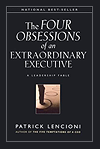Consistent with his other leadership fables, Lencioni draws you quickly in to the corporate intrigue at Telegraph Partners, a fictitious technology consulting group whose CEO, Rich O’Connor, struggles with his leadership role in sustaining the success of the company. While Rich gains focus and direction, Lencioni weaves four disarmingly simple disciplines of a healthy organization through the story.
No one but the head of an organization can make it healthy. While executives often successfully delegate responsibility for strategy, technology, marketing, or finance to their direct reports, they cannot assign responsibility for their organization’s cultural well-being to anyone but themselves.
All successful organizations share two qualities, they are smart and they are healthy. Most leaders spend the majority of their time and energy making their organizations smarter with little effort directed toward making them healthier. This is understandable considering the predominant focus of business schools and business media. However, a healthy organization eliminates politics and confusion which leads to higher morale, lower turnover, and higher productivity.
The first step to organizational health is to embrace the idea that, like so many other aspects of success, organizational health is simple in theory but difficult to put into practice. It requires extraordinary levels of commitment, courage and consistency. However, it does not require complex thinking and analysis; in fact, keeping things simple is critical. The second step is to master these fundamental disciplines and put them into practice on a daily basis.
Discipline 1: Build and Maintain a Cohesive Leadership Team
Cohesive teams build trust, eliminate politics, and increase efficiency by…
Knowing one another’s unique strengths and weaknesses
Openly engaging in constructive ideological conflict
Holding one another accountable for behaviors and actions
Committing to group decisions
Discipline 2: Create Organizational Clarity
A healthy organization minimizes the potential for confusion by clarifying. . .
Why the organization exists?
Which behavioral values are fundamental?
What specific business it is in?
Who its competitors are?
How it is unique?
What it plans to achieve?
Who is responsible for what?
Discipline 3: Over-Communicate Organizational Clarity
Healthy organizations align their employees around organizational clarity by communicating key messages through. . .
Repetition: Don’t be afraid to repeat the same message, again and again.
Simplicity: The more complicated the message, the more potential for confusion and inconsistency.
Multiple Mediums: People react to information in many ways; use a variety of mediums.
Cascading Messages: Leaders communicate key messages to direct reports; the cycle repeats itself until the message is heard by all.
Discipline 4: Reinforce Organizational Clarity through Human Systems
Organizations sustain their health by ensuring consistency in. . .
Hiring
Managing performance
Rewards and recognition
Employee dismissal
The model described here is a holistic one: each discipline is critical to success. And because every organization is different, each will struggle with different aspects of the model. Executives must keep two things in mind if they are to make their organizations successful. First there is nothing more important than making an organization healthy. Regardless of the temptations to dive into more heady and strategically attractive issues, extraordinary executives keep themselves focused on their organization’s health. Second, there is no substitute for discipline. No amount of intellectual prowess or personal charisma can make up for an inability to identify a few simple things and stick to them over time.



